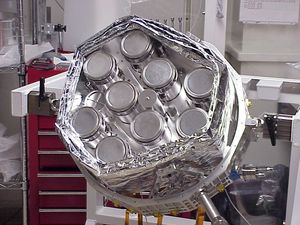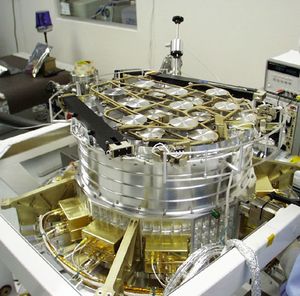
- The RHESSI Spacecraft bus getting prepped inside a clean room at SSL.
Spacecraft Bus
The Spacecraft Bus consists of the structure and mechanisms, the power system (including the battery, solar panels, and control electronics), the attitude control system, thermal control, command and data handling (C&DH), and telecommunications.
The spacecraft structure shown here provides support for the telescope and other components. It was manufactured out of aluminum parts to be light weight but strong. The equipment platform has a honeycomb structure to further reduce the weight. The Spacecraft was manufactured in Gilbert, Arizona by Spectrum Astro, Inc.

- The RHESSI imager assembly.
Imaging Telescope Assembly
The Imaging Telescope Assembly consists of the telescope tube, grid trays, Solar Aspect System (SAS), and Roll Angle System (RAS). It was constructed, assembled, aligned, and tested at the Paul Scherrer Institut in Switzerland. The front and rear grid trays are attached to the telescope tube (shown here). It maintains the separation and alignment of the trays.

- The RHESSI grids in the grid tray
Grid Tray & Grids
Nine grids are mounted on a grid tray at each end of the telescope tube. The grid pairs modulate the transmission of solar flare x-ray and gamma-ray emissions through to the detectors as the spacecraft spins around the axis of the telescope tube. The modulated count rates in the nine detectors are used in computers on the ground to construct images of solar flares in different energy bands.
The five coarse grids (square) were constructed by Van Beek Consultancy in The Netherlands. The four fine grids (round) were constructed by Thermo Electron Tecomet in Massachusetts. All grids were characterized both optically and with X-rays at Goddard before being shipped to the Paul Sherrer Institut for integration into the imaging telescope assembly.

- The nine RHESSI detectors
Spectrometer
The spectrometer contains nine germanium detectors that are positioned behind the nine grid pairs on the telescope. These artificially grown crystals, pure to over one part in a trillion, were manufactured by the ORTEC division of Perkin Elmer Instruments. When they are cooled to cryogenic temperatures and a high voltage is put across them (up to 4000 V), they convert incoming x-rays and gamma-rays to pulses of electric current. The amount of current is proportional to the energy of the photon, and is measured by sensitive electronics designed at the Lawrence Berkeley National Laboratory and the Space Sciences Lab., Berkeley.
The detectors are cooled with an electromechanical cryocooler (built by Sunpower, Inc. and flight qualified at Goddard). It maintains them at the required operating temperature of minus 324 degrees Fahrenheit (minus 198 degrees Centigrade, or 75 degrees above absolute zero).

- The RHESSI spectrometer with removeable attenuators.
Attenuators
Removable attenuator disks are part of the spectrometer. They can be moved in front of the germanium detectors during intense solar flares. In this position, they attenuate the flux of solar flare X-rays that reach the detectors and hence prevent saturation effects that occur at high count rates. When not in place, RHESSI is much more sensitive to softer X-rays and weaker flares can be detected.
The attenuators were fabricated by Tecomet, characterized at Goddard and assembled, tested and integrated with the spectrometer at Berkeley.



